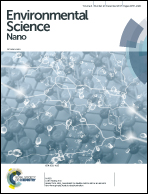Hierarchical MoS2 nanosheets on flexible carbon felt as an efficient flow-through electrode for dechlorination†
Abstract
MoS2, a layered transition metal dichalcogenide, is well-known as an efficient catalyst for the hydrogen evolution reaction. For the first time, we show that MoS2 is also a promising electrocatalyst for reductive dehalogenation of chloro-substituted carboxylic acids in water. MoS2 nanosheets were grown directly on flexible/soft carbon felt using a facile hydrothermal method. The MoS2 nanosheet loaded carbon felt was used as flow-through electrode for reductive dechlorination of trichloroacetic acid under environmentally relevant conditions resulting in a much more efficient process than using metal electrodes. Atomic hydrogen produced from water reduction at the MoS2 surface can be exploited to accomplish a complete dehalogenation, yet with a dramatic drop in the Faradaic efficiency due to the concomitant dihydrogen evolution. Doping of the MoS2 catalyst with transition metals resulted in an increase in the Faradaic efficiency as well as the complete dechlorination of trichloroacetic acid to acetic acid. The edge sites of MoS2 are believed to be responsible for the indirect dechlorination involving atomic hydrogen. With the cobalt doped MoS2 catalyst, 100% full dechlorination was accomplished at an applied potential of −1.1 V vs. Ag/AgCl using a flow rate of 1 mL min−1. The catalyst synthesis, electrode preparation, and setup of the electrochemical flow cell are straightforward and readily up-scaled, demonstrating the potential of this methodology in practical applications.



 Please wait while we load your content...
Please wait while we load your content...